Ten years ago this fall, the College of Engineering became the Jerome J. Lohr College of Engineering to honor the man who had at that point given in excess of $10 million to college construction projects.
Lohr, a 1958 civil engineering major who made his mark in winemaking and home construction, was instrumental in fueling the College of Engineering construction boom that began in the late 1990s, including the construction of Architecture, Mathematics and Engineering Hall. In fact, it was at the Oct. 4, 2013, formal groundbreaking for the building that the college was renamed in Lohr’s honor.
The standard of excellence that has been an attribute of Lohr throughout his career has been mirrored by efforts within the college during the past decade.
With this final issue of Engineering Connection for 2023, it seems appropriate to reflect on the past decade and delineate 10 milestones within the college in the past 10 years.
After soliciting input from current and former college administrators, the milestones were narrowed to:
- Establishment of the concrete industry management program.
- Awards of excellence to faculty members by their peers.
- Growth in scholarships.
- Endowing the dean’s position.
- Student competition success at the national level.
- Advancing all three NASA student projects to the finals in 2023.
- Growth in academic programs.
- Growth in external research expenditures.
- Growth of endowed positions.
- Continued building construction.
Details behind each milestone selection follows.
Establishment of concrete industry management program
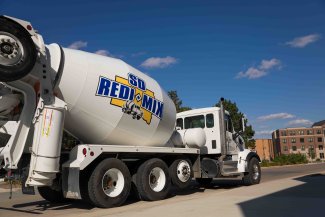
Citing South Dakota State’s strong commitment to a concrete industry management program, favorable tuition rates, laboratory and classroom facilities and past experience with public-private partnerships, the Concrete Industry Management National Steering Committee announced on Nov. 6, 2020, that a formal agreement is in the works for SDSU to offer a four-year bachelor’s program in concrete industry management.
Initially financed by a $1.5 million gift over five years from industry boards, the program launched in fall 2021 with two students. Subsequently, the gift was increased to $2 million over five years with the addition of another $100,000 per year from the national group for the purpose of funding a dedicated recruiter.
Inaugural director Tim Hostettler, who began in July 2021, reports there are currently 28 students with a long-term goal of 100. The program will have its first graduate in spring 2024.
Awards of excellence to faculty members by their peers
SDSU faculty members continue to gain more prominence among their peers. Among those honored over the past decade have been: (listed alphabetically by department)
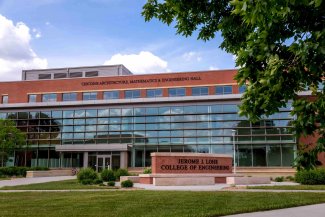
Agricultural and Biosystems Engineering
• John McMaine, associate professor in ag and water resources, won two Extension Blue Ribbon awards on conservation drainage from American Society of Agricultural and Biological Engineers in 2022. One was for a video series on storing water in the landscape, and the other was for a podcast on streamlines.
In 2019, he won an Education and Public Service Award from the North Central Region Water Network. In 2018, he won a National Excellence in Multistate Research Award from the United States Department of Agriculture (USDA).
• Muthu Muthukumarappan, current distinguished professor and department head, was named a fellow in the American Society of Agricultural and Biological Engineers in 2013. In 2015-17, he received the Fulbright-Nehru Research Scholar Award and in 2019 he received the Fulbright Specialist Award.
• Nicholas Uilk, an endowed educator in precision agriculture, won a national teaching award from the Association of Public and Land-grant Universities in recognition of excellence in agricultural sciences teaching and student engagement at the association’s annual meeting Nov. 4, 2020.
Also in 2020, he received the USDA Excellence in Teaching Award. In 2022, he received the PrecisionAg Award of Excellence as Educator/Researcher of the Year. In 2023, he was the Lamont-Rhodes Lecturer on precision agriculture at Northern State University.
• Lin Wei, an associate professor and graduate coordinator, was named outstanding associate editor in 2019 and 2022 for the American Society of Agricultural and Biological Engineers journal. Young Chang, an assistant professor and precision agriculture automation engineer, and Sushant Mehan, an assistant professor and water resource engineer, were both named outstanding reviewers for the journal in 2023.
Civil and environmental engineering
• Zach Gutzmer, a lecturer, was named outstanding young engineer for the eastern South Dakota branch of the American Society of Civil Engineers in 2013. In 2017, he received the Daniel Mead Prize for Younger Members and in 2019 he was named outstanding faculty/practitioner adviser for ASCE Region 7.
• Rich Reid, now retired associate dean, and Nadim Weibe, department head, were both named fellows in the American Society of Civil Engineering. Reid was inducted March 16, 2017, and Weibe in October 2015. Only 3.5% of the membership in America’s oldest national engineering society receive this honor.
Weibe also was named a fellow of the Structural Engineering Institute in 2014.
Electrical engineering
• Tim Hansen, associate professor, received the Institute of Electrical and Electronic Engineers-Eta Kappa Nu Outstanding Teaching Award in 2019 and the Graduate of the Last Decade for Milwaukee School of Engineering in 2020.
Mathematics
• Chris Saunders, a professor in mathematics and statistics, received a MITRE Corp. distinguished paper award in 2014 as well as one from the International Conference on Chemical, Agricultural, Biological and Environmental Sciences in 2019.
Other
• Larry Leigh, current head of the Image Processing Lab, in fall 2015 became the first SDSU researcher to receive a Google Earth Engine Research Award. Through the one-year, $46,000 grant he was able to use Google Earth images to find more sites to calibrate imaging satellites.
Growth in scholarships
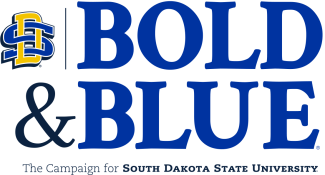
Bold and Blue, the SDSU’s current fundraising campaign, has received $162 million in commitments for scholarships out of its record efforts, which stands at $517 million with almost five months left to go.
Gifts made since Jan. 1, 2017, count toward the total, and the Jerome J. Lohr College of Engineering has already felt the impact. In the 2018-19 school year, SDSU engineering students were awarded 273 scholarships. These privately funded scholarships overseen by the SDSU Foundation had a total value of $732,225. For the 2023-24 school year, 322 scholarships valued at $1,389,630 were awarded.
That is an 18% increase in scholarship volume and a whooping 90% increase in scholarship funds.
In addition, engineering students are able to take advantage of general university scholarships, such as the Yellow and Blue, Jackrabbit Guarantee and Jackrabbit Journey scholarships. In 2018-19, 370 of those awards went to engineering students, receiving $466,663. In 2023-24, those numbers had grown to a whooping 391 awards for $792,080.
That means engineering students received nearly $2.2 in scholarships for the current school year.
Sanjeev Kumar, dean of the college, said that growth is critical as SDSU continues its land-grant mission to make a college education affordable and attainable for all. “These gifts can help us attract top-tier students as well as first-generation college students. They allow students to participate in extracurriculars and career-building clubs.”
Endowing the dean’s position
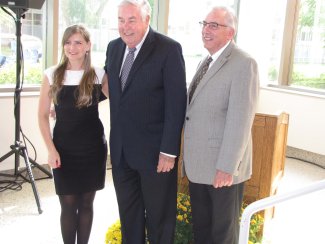
On Aug. 26, 2021, SDSU President Barry Dunn announced that Jerome J. Lohr was committing $5 million to endow the dean of the college that has carried his name since 2013. The endowment provides at least $200,000 a year in perpetuity to allow the dean to support strategic needs of the college.
Bruce Berdanier became the first Lohr Endowed Dean. Sanjeev Kumar followed him on June 22, 2022.
Student competition success at the national level
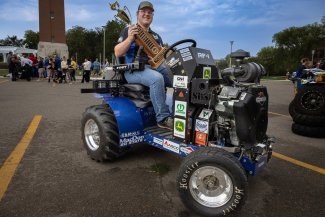
SDSU engineering didn’t start having success in contests against their peers just in the past 10 years, but it certainly has accelerated in the Lohr decade.
The American Society of Civil Engineers first presented the Ridgway Award to the nation’s top student chapter in 1965. SDSU won the award in 1998 and 2004. With Ridgway Awards in 2022 and 2023, SDSU became the first chapter to repeat since Cal Poly-San Luis Obispo won the award in 2009, 2010 and 2011.
The Jackrabbit Tractor Club also scored a back-to-back national championship in the International Quarter-Scale Tractor Student Design competition in 2023. SDSU also won the title in 2018 and was runner-up in 2017 and 2019.
The Human-Powered Vehicle team (think bicycles with unique engineering features) was the national champion in 2019 and was third in 2023.
Advancing all three NASA student projects to the finals in 2023
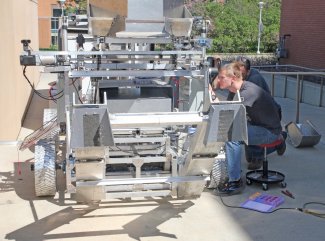
Three for three. That’s an impressive percentage in any difficult challenge, but when all SDSU engineering projects that entered NASA contests qualified for the finals, it produced out-of-this-world excitement in the mechanical engineering department, where most of the students were based.
SDSU was one of 15 finalists in the Revolutionary Aerospace Systems Concepts – Academic Linkage (RASC-AL) competition. Competing in the lunar surface transporter vehicle category, SDSU came in first, beating Maryland, Texas and Virginia Tech. The team designed and built a self-driving, customized forklift.
SDSU’s Break the Ice Lunar Challenge team is among 15 finalists to build and operate equipment that could excavate and haul frozen lunar soil. It is competing against two other schools, firms from India and the Netherlands and U.S. space engineering firms, including Redwire Space. Results will be announced later in December.
SDSU was one of six finalists in the FLOATing DRAGON balloon challenge, which included engineering bluebloods like Princeton, Purdue and the University of Texas. FLOATing DRAGON is NASA shorthand for Formulate, Lift, Observe And Testing; Data Recovery And Guided On-board Node. That balloon-launching and dropping contest was in August in New Mexico.
Growth in academic programs
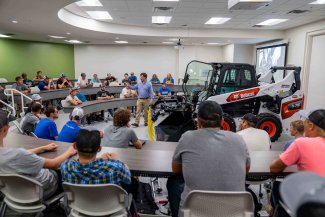
The past decade has seen significant increases in academic offerings, particularly at the graduate levels.
Doctoral degrees in agricultural and biosystems engineering, mechanical engineering and computer science departments are now awarded within their respective departments.
At the undergraduate level, in addition to the concrete industry management degree, there are now degrees in data science, from associate to master’s, in addition to a minor.
In fall 2016, SDSU became the first university in the nation to offer a four-year bachelor’s degree in precision agriculture following South Dakota Board of Regents approval in July 2016. The program is a cooperative effort of the agronomy, horticulture and plant science department, agricultural and biosystems engineering and mathematics and statistics.
New classes were created in all three departments to form the precision ag major, according to Van Kelly, then head of agriculture and biosystems engineering.
Growth in external research expenditures
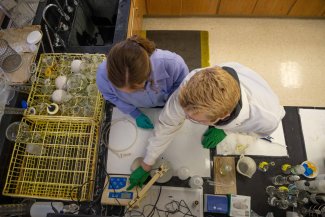
Faculty achievement and increased external research awards often run current. In fiscal year 2022, the college’s external research awards hit $7.6 million, a huge jump from prior years.
The awards were at $3.2 million for FY 2018, $4.5 million for FY 2019, $5.6 million for FY 2020 and $5.9 million for 2021.
Award levels tend to be volatile, depending on who is on the faculty, their research interest and availability of government funds.
Rajesh Kavasseri, associate dean for research, said it is important to keep a focus on research awards because of the visibility, distinction and prestige it brings to SDSU.
Growth of endowed positions
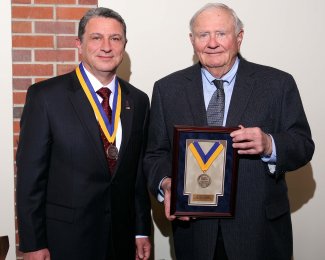
In 2013, the college had one endowed position — the Harold C. Hohbach Endowed Professorship in Electrical Engineering. By this fall, that count is up to seven.
The positions and the current holders of the titles:
• Jerome J. Lohr Endowed Dean for the Jerome J. Lohr College of Engineering, Sanjeev Kumar (see separate milestone entry.
• Klingbeil Endowed Department Head for Agricultural and Biosystems Engineering, Kasiviswanathan “Muthu” Muthukumarappan.
• Harold C. Hohbach Endowed Professorship in Electrical Engineering, Tim Hansen, Junjian Qi (two positions).
• Klingbeil Endowed Educator in Precision Agriculture, Nicholas Uilk.
• Kemp Endowed Professor in Honors Mathematics, Christine Larson.
• John M. Hanson Professor in Structural and Construction Engineering, Nadim Wehbe.
Also, the Associate Professor of Practice in Concrete Industry Management, held by Tim Hostettler, is funded by industry for five years.
Continued building construction
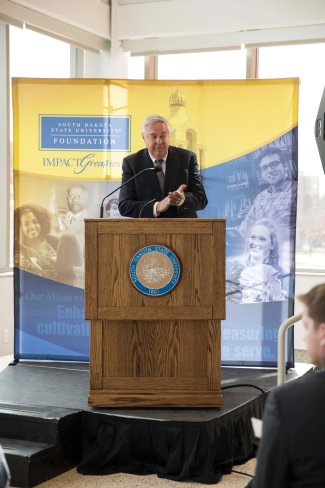
Much of the college’s physical renovations were built before the Lohr era began. However, two of the largest fit in that window.
Formal groundbreaking for the Architecture, Mathematics and Engineering Hall was Oct. 4, 2013, during a ceremony in which the college was officially recognized as the Jerome J. Lohr College of Engineering. The 62,000-square-foot structure was built for $17 million and dedicated April 24, 2015, with classes beginning in the fall.
Formal groundbreaking was Oct. 6, 2018, for the Raven Precision Agriculture Center with dedication Sept. 11, 2021. At 122,694 square feet, the facility has a footprint of 2.8 acres. The $46.1 million facility puts the Department of Agricultural and Biosystems Engineering from the Lohr College of Engineering and Department of Agronomy, Horticulture and Plant Science from the College of Agriculture, Food and Environmental Sciences under one large roof on the northwest corner of campus.
Crothers Engineering Hall’s major addition and renovation preceded the Lohr era, but two phases of significant remodeling were undertaken in the past decade.
In mid-September 2021, the civil and environmental engineering department took possession of a new suite on the third floor and faculty offices also moved to third floor while on the first floor the mechanical engineering department is enjoying expanded and renovated labs after moving from the third floor.
The first half of 2018 saw the completion of the Jerome J. Lohr College of Engineering dean’s suite and the mechanical engineering department head suite. The demolition of the former dean’s office and an adjacent classroom was started in the summer 2017. Construction on the 1,818-square-foot, $425,000 project began in early 2018 with move-in May 11-14.
Upgrades to the mechanical engineering department head’s office suite were undertaken in summer 2018 and completed in time for classes.
Classroom and lab renovations of third-floor Crothers allowed Engineering Extension and Local Transportation Assistance Program (LTAP) to move there from Harding Hall in March 2016.
- Contact:
- Telephone number: 605-688-4538
Republishing
You may republish SDSU News Center articles for free, online or in print. Questions? Contact us at sdsu.news@sdstate.edu or 605-688-6161.

